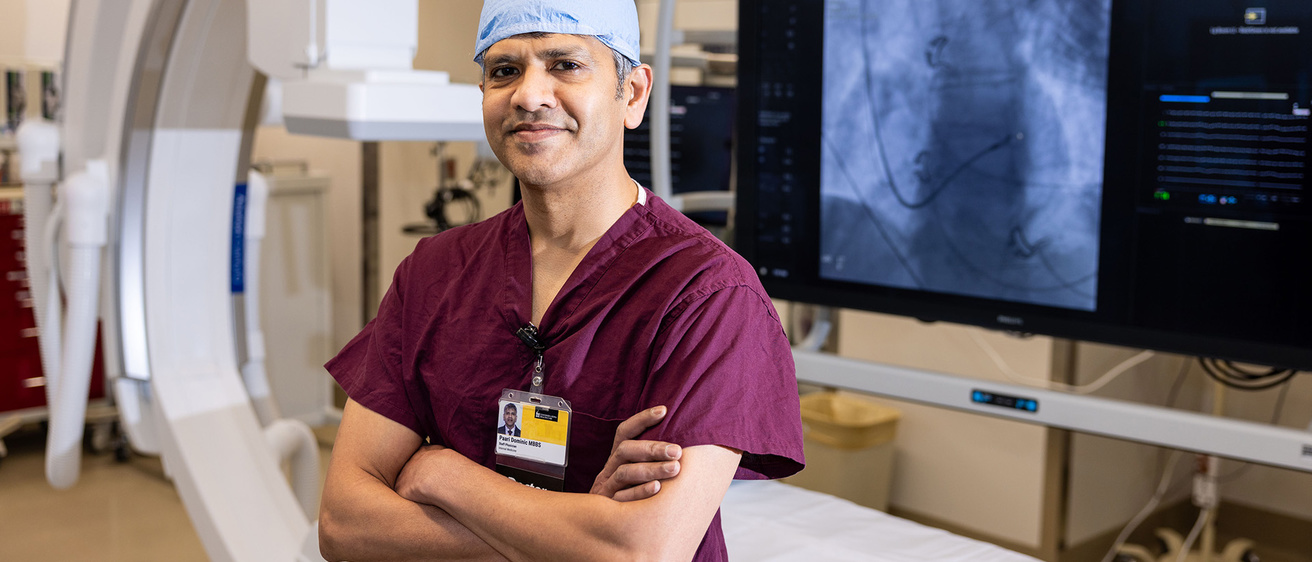Heart rhythm issues, whether too slow or too fast, can cause significant mortality or morbidity in patients. Paari Dominic, MBBS, MPH, a cardiac electrophysiologist at University of Iowa Hospitals & Clinics, focuses on the electric system of the heart to address these issues.
“I take pride in the fact that I can make a big change in the quality of life in my patients,” says Dominic, director of electrophysiology and medical director of the Electrophysiology Lab. “Atrial fibrillation and other cardiac rhythm problems can cause severe restrictions of what patients can do. At Iowa, we can offer cutting-edge techniques to alleviate these problems.”
Dominic, who was a fellow at Iowa from 2007 to 2012, gained experience at Yale New Haven Hospital and LSU Health Sciences Center before returning to the University of Iowa earlier this year. He is one of the few doctors in the nation (and the only one in Iowa) who specializes in a new procedure called cardioneuroablation, which involves burning nerve endings inside the heart to increase the resting heart rate and to prevent a sudden drop in heart rate leading to fainting.
In April 2023, Dominic performed this procedure on a St. Ambrose student-athlete whose disturbingly slow heart rate derailed her career—and threatened her life. The former soccer player is active once again and busy pursuing a doctorate.

Dominic took a few minutes to share what he enjoys about his work and the appeal of being back at UI Hospitals & Clinics.
Why did you decide to become a doctor and surgeon?
Well, I didn’t always want to be a doctor or surgeon. Growing up, I was fascinated by cinematography, and I actually went to an engineering school first. It was there that I realized my strength was interacting with people, not with machines and tools. Within three months, I said, “OK, this is not for me,” and I went back home.
My parents were both physicians. My brother was a physician. My sister-in-law is a physician. For years, I thought I was just tuned differently, but eventually I realized I’m not all that different from them. I really like the patient interaction aspect of my work. I love talking to patients—especially in the clinic setting, where they’re not under stress or sedation. The amount of love and affection people in this state and country have shown me is just beyond description.
Why did you come to Iowa for your fellowship in 2007?
The person who was instrumental in me coming to Iowa was Mark Anderson, the chair of cardiology at that time. He would become the chair of internal medicine, and now is the dean of the Pritzker School of Medicine at the University of Chicago. I was interested in being a physician scientist. My targeted institutions were all places that trained physician scientists. And I remember going to some Ivy League programs—at those places, I felt they treated me like I was just an inexperienced trainee coming in for an interview.
“I spent time in other premier academic institutions—Yale, LSU—and I realized just what a fantastic experience I had at Iowa.”
—Paari Dominic, MBBS, MPH
But at Iowa, I was treated as a genuine researcher and a mature physician, and the whole interview process revolved around my research interests. Every single person that came into that room to interview me—nine of them, far more than at the other institutions—all were handpicked by Mark Anderson, and that showed me how healthy the experience in Iowa can be as a fellow. I was impressed. I spent five years here as a fellow—three years of cardiology fellowship, two years of postdoctoral fellowship. It was one of the richest academic experiences I’ve ever had.
You were at Louisiana State University for nearly a decade before returning to Iowa. Why did you decide to return to Iowa City?
I probably would not have had so much gratitude and respect toward this great institution if I hadn’t left it. I spent time in other premier academic institutions—Yale, LSU—and I realized just what a fantastic experience I had at Iowa.
At LSU, I was the director of electrophysiology for eight and a half years. I was able to grow the program. When I started, I was the lone electrophysiologist, and we had just one site of practice; over time, the program grew to four electrophysiology faculty at three sites of practice. But the academic productivity of Iowa is unmatched anywhere you go.
When Cari Harland, who’s the cardiology fellowship program coordinator here, reached out to me about the open faculty position here, I took up the opportunity to return and give back to the institution that gave so much to me. I’ve loved being back here because of how much I’ve been able to grow, both as a person and as a professional.
Why are you interested in the human heart?
I think the perfect analogy for me is, it’s like a car engine. It has all the perfect components that you would build into the most advanced and intelligently designed hydraulic machine. It has pipes, it has flow of liquid fluid power into those pipes, it has electricity that governs the combustion and the energy of the engines, and then you have valves that open and close. I don’t think there’s any other organ in the body that is exactly like that. I think it’s fascinating.
I said this when I returned to Iowa, and it’s worth repeating: Bringing the rhythm back to my patients’ hearts, I believe, is essential to bringing the rhythm back to their lives. I am grateful that Iowa provides me with the finest people, state-of-the-art technological resources, and the conducive environment needed to provide the best care to my patients.
